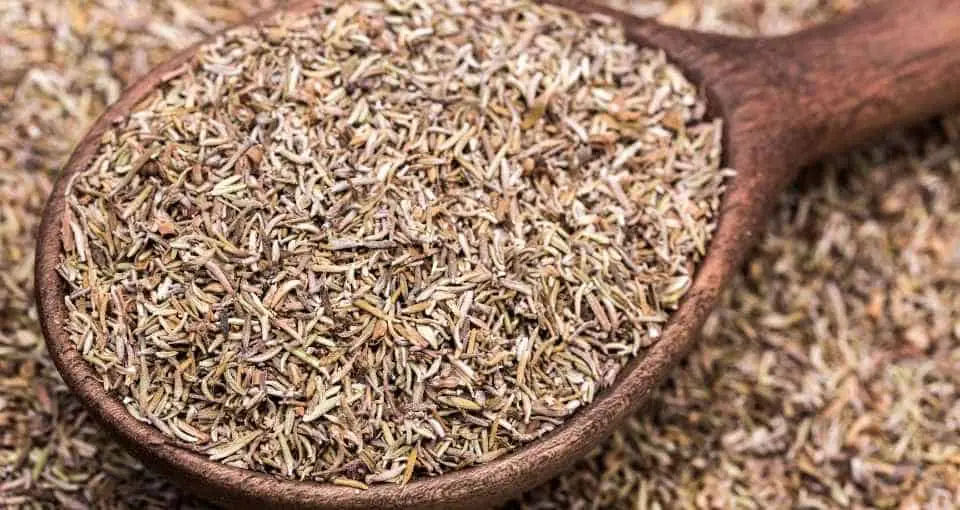Many cuisines include thyme herb in their recipes, including Mediterranean, French, Middle Eastern, and Italian. You will learn how to use fresh or dried thyme as well as ways to store it properly to increase its longevity in your kitchen.
Fresh thyme from the store is often in bundles. It is unnecessary to chop this herb because it can quickly come off the woody stem with your hands. Hold a sprig of thyme at the top with one hand, then pinch and slide your fingers down the stem with your other hand to remove its leaves.
Storing Thyme
When fresh, it can keep for up to two weeks in the fridge. Keep the thyme dry and store it in its clam shell container. You may also wrap it in a damp paper towel and leave it in an unsealed bag in the fridge. If you use the latter method, check the herbs every few days to change the paper towel and dispose of any wilted sprigs.
Keep in mind that storing thyme while still moist will make it go bad much faster, and the leaves will start to fall off prematurely. Always pat your fresh herbs dry before storing them in the fridge. If you want to grow thyme, it is a hardy perennial plant, so even the least experienced gardeners would have a hard time killing this herb.
What Foods Go With Thyme
When cooking with fresh thyme, it is alright to add it early on in the cooking process, unlike other fresh herbs such as basil or parsley. The pungent flavor of thyme needs enough time to release its aromas and mellow out; otherwise, it may overpower your dish. You can pair thyme with sea bass and salmon since it has a citrus note that complements fresh lemon juice, often used to finish off seafood dishes.
Another way to use this herb is by melting butter with it to baste meats. Lamb is one of many types of meat that pairs well with thyme because it helps offset the gamy flavor. For example, lemon and thyme or rosemary and thyme lamb chops are lovely combinations that will always complement each other. Fresh thyme is also versatile enough to be used in marinades for grilled steaks or chicken thighs. You can even use it in a spice rub for pork ribs or brisket. The possibilities are virtually limitless when it comes to thyme.
Most root vegetables and even things like mushrooms or butternut squash taste good with thyme too. For example, you can roast potatoes, carrots, and onions with oil, fresh thyme, and other seasonings on a sheet pan for an easy side dish. Dried thyme works just as well if you don’t have fresh thyme on hand to use in this and other recipes like a creamy white bean and thyme soup. You can also add a pinch of thyme to crusty homemade bread recipes to bring an element of freshness to them. Another idea is mixing oil, dried oregano, thyme, garlic, and a splash of balsamic vinegar as a bread dip. Dipping bread in olive oil isn’t an Italian thing per se, but many “Americanized” Italian restaurants have adopted this tradition.
Dried thyme is more concentrated, so be careful not to use too much of it at once. As a rule of thumb, use one-third the amount of dried thyme when substituting it with fresh thyme. For example, one tablespoon of fresh thyme is equivalent to one teaspoon of dried thyme. When storing your thyme outside of a fridge, one thing you can try is to hang it in bunches in a dry location or simply use a food dehydrator to dry them. Once they are ready, keep the dried herbs in an airtight container away from any heat or light. Doing this helps the thyme retain its flavor for several months.
Herbs To Pair With Thyme
Other herbs that go well with thyme include basil, bay, chives, marjoram, oregano, parsley, rosemary, sage, and tarragon. It makes sense that these kinds of flavors go together since many Mediterranean and Italian recipes use them quite often. If you want, you can tie some of these fresh herbs together with string to make your own dried herb bundles. These bundles can come in handy for soups or stews. Another thing to consider is giving them as gifts to friends, neighbors, and family members.
As you can tell, thyme is a noteworthy and versatile herb. It is hardy enough to withstand recipes with long cooking times and retains its flavor even when dried. We hope you enjoyed learning about thyme and encourage you to try new recipes and cuisines to take advantage of this flavorful and distinctive herb. To help you get those creative juices flowing here’s an easy recipe you can try.
Thyme & Italian Sausage Recipe
Set a pot of water on the stove on high to cook some linguine pasta. While you’re waiting, cook Italian sausages in a pan until they are no longer pink. You can remove them from the casings and grind them up to speed up the cooking process.
Next, add diced onions, sliced mushrooms, and minced garlic to your sausage and continue cooking until they are soft. Lastly, pour in heavy cream, fresh thyme leaves, salt, and pepper, and add it to your pan to create a sauce. Let the cream come to a boil to thicken it, and add the cooked noodles at the very end. Coat the pasta evenly in the sauce and serve your dish with some pecorino Romano cheese.
Can You Substitute Lemon Thyme for Regular Thyme?
Lemon thyme has only a very subtle difference in aroma and flavor from regular. Both can be substituted for each other without noticeable changes in taste. You also won’t see a difference in appearance when adding them to your foods and they can used the exact same way while cooking.
There are a lot of different thyme herb plants to chose from. Around 300 varieties exist due to cross-breeding but many aren’t used in cooking. Actually common thyme (aka regular) and lemon thyme (also called citrus thyme) are two of the most common.

